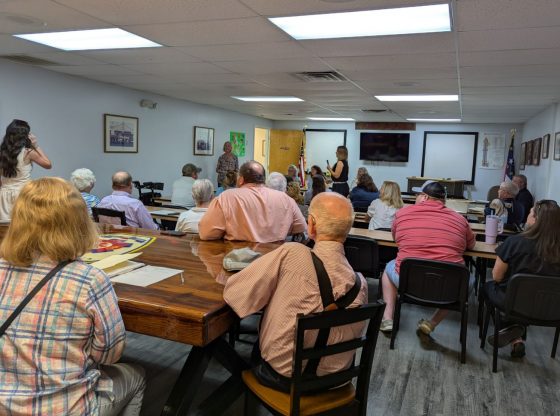The Moore County Board of Commissioners held a public hearing last Tuesday on what has become a hot topic: proposed changes to the Moore County Sheriff’s Office Animal Services. Chief Deputy Andy Conway outlined some of the proposals. The plan involves establishing an in-house surgical suite and hiring a full-time veterinarian to reduce euthanasia rates.
Before the hearing, Conway outlined conversations held last March with Dr. Tom Daniels of Sandhills Spay and Neuter in Vass. Animal Services told Daniels that they needed more accurately vetted documentation and were told that the current vetting process is “invasive” and takes hours to complete. Daniels also said the income cap for a procedure is too high at $75,000 and that it should be lowered to $50,000 to ensure they were serving the “appropriate population.”
Another change offered would be to set up a volunteer program. Conway, Commission Chairman Nick Picerno and County Manager Wayne Vest visited the Guilford County shelter to see what was going on in surrounding communities and were positively impressed with the operation. Conway’s takeaway from the visit was that Guilford County has a volunteer coordinator who works with all their volunteers, and they apply strict compliance rules.
Complaints about the shelter were brought up. One complainant said they’d had problems with shelter staff and felt people should be allowed into the kennel areas, the insinuation being that Animal Services was trying to “hide something.” This was denied. People were told that any complaints should be filed with the Department of Health and Social Services, which would come and conduct a thorough inspection. One such inspection took place in January. One deficiency was found: an epoxy floor, which was known and budgeted for. Repair to the floor was completed in April.
A sensitive topic was euthanasia rates. It was brought up that the number of animals euthanized in Moore County last year was 1290. Conway said that overlooked the fact that 777 of those animals were put down at the request of their owners, leaving 513. Fifteen percent of those were sick or injured, and 10.9% had problems with temperament: aggression, for example.
Conway proposed the possibility of a surgical suite at the shelter with an in-house veterinarian, which was the beginning of the concept they’re now working on.
“So where are we going?” Conway asked. “The idea of local government is to provide services that are useful to all of our taxpayers. It’s our job to present them to you, the commissioners, with relative and realistic options, and when presented with a problem, to discuss the best path forward when allocating taxpayer monies. Our recommendation is to hire a veterinarian and construct a surgical suite simply to provide that veterinarian with all the tools available in an effort to reduce euthanasia rates and save as many animals as possible to increase their chances of adoption. In no way are we hiring a veterinarian to be in competition with anyone, including Sandhills Spay and Neuter.”
He outlined the pros and cons of such a project:
Pros:
Improved animal care
Efficiency and cost savings
Improved adoption rates: Healthy animals are more likely to be adopted
Staff education and training provided by an on-staff veterinarian
Better emergency response.
Cons:
The cost: hiring a veterinarian can be expensive
Continuous costs of maintaining medical supplies and equipment
Resource allocation
Dependency: relying on one veterinarian can be risky if the vet is unavailable for some reason, such as time off or illness.
Finding and recruiting a vet who is willing to work in a shelter environment may be challenging.
Workload burn-out.
Conway said hiring a full-time vet could reduce euthanasia rates, as well as quality temperament testing but may be prohibitive due to cost and expectations. The total vet package may be as high as around $130,000, with surgical suite equipment at $40-80,000.
“Current animal services budget is $1,027,000,” said Conway. “It’s not and never will be a revenue-producing department. They can’t be discriminatory – they must accept all animals despite condition. They face emotional backlash, but we cannot allow emotions to play a part in our operations.”
Liability may rest on the county if they accept aggressive animals. Conway says a dog-bite case may run to $50,000, and they don’t want taxpayers to have to pay that.
Several people spoke during the public comment period, and the main area of concern was how to reduce euthanasia rates. One resident’s concern was getting the word out about adoptable animals, suggesting that social media could be used better, as well as advertising in local news outlets.
Deborah Wilson, a founding member of the Companion Animal Clinic of the Sandhills Foundation, spoke and said, “I retired from the foundation board. I know the spay and neuter business from the ground up. I’m really surprised; I’m disappointed that the county and the clinic have been unable to work in conjunction with each other because the end result is a cost to taxpayers for an existing practice, set up for the county, and serving 15 other counties. The fact that the clinic… the foundation… is funded by private donations. The county didn’t spend one dime on the clinic. I came to you guys in 2006, a different board, obviously, and I said what we were going to do. We got our 5013C number, and it won’t cost you anything. We said to use our service, and you did. And it worked for years.”
Now, she’s concerned that building a whole new spay/neuter facility just doesn’t make any sense.
“There’s a mobile spay/neuter clinic,” said Wilson. “Get your vet and bring the mobile unit over. Work out an agreement. That clinic can do 60-80 surgeries a day. There’s no reason to duplicate it. Bringing a vet in is a good idea, but it makes no sense to open a whole new surgical suite.”
Jean and Bill Hammond also spoke during the hearing. Both have been involved for years in animal causes.
Jean Hammond echoed Wilson, saying she doesn’t understand why the county can’t just work with established animal clinics and why they don’t use volunteers. She says she’s been in contact with animal shelters in Cumberland and Guilford counties and that volunteers are essential.
“We have lots of residents here who love animals,” said Jean. “Why don’t we try them? I see this as just another way to get more money from taxpayers with no more adoptions.”
A Pinehurst resident’s complaints centered on communication. “Horrible communication between sheriff’s office and the spay/neuter clinic you used to do business with.” She said there is not enough information as to how to get these animals out for adoption. “You can spay and neuter until the cows come home, but if the animals are still not getting out there, what are you gonna do?”
At one point, attendees were admonished to stop applauding speakers, which is generally not allowed during public hearings.
The idea of establishing a volunteer program was generally well-received by the attendees, with the main point of disagreement being whether a spay-and-neuter clinic and a surgical suite would be cost-effective and help to bring down the euthanasia rate and improve the number of dogs and cats being adopted.
Picerno thanked the speakers after the public hearing.
 ~Written by Sandhills Sentinel reporter Steve Biddle.
~Written by Sandhills Sentinel reporter Steve Biddle.
To sign up for the free Sandhills Sentinel weekly e-newsletter, please click here.



















